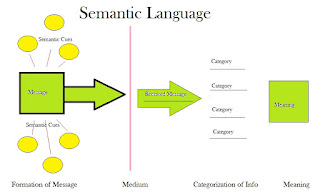Semantics is a concept that helps define a word
within the context of other words. It is often derived from word selection and
connotation. Semantics can come from multiple forms of subtle meaning to create
impressions in the listener's mind. Those who can master semantics can create
higher forms of communicative ability and influence. From sales opportunities
to leadership semantics has a huge impact on how each of the individual parts
of a message creates a whole understanding of that message.
In general, semantics can take information from multiple
sources such as tone, word choice, word order, facial expressions
(paralanguage), and other subtle impressions that help define the full message.
When used in combination the clarity of language is enhanced due to its focus
of symbolism to create a single shared meaning both in part and together. To understand
how they work together can create a powerful message.
Each sentence and word is associated with those
around it and within the context of the environment. The way in which people
make connections between this information can be argued as either an inborn
part of natural language or developed throughout cultural vantage points. Many
researchers are still unsure of which philosophical approach to take. However,
they do agree that the connection of words to their meaning occurs through
cognitive abilities and is associated with higher thought.
Research helps show how semantic enhancement of
language is associated with the personal abilities of individuals. For example,
those who are in tune with music are also more capable in semantic usage (Bidelman,
et. al, 2013). This is associated with their higher perceptual understanding of
tones and the ability to discern between subtleties. A large body of research
associates artistic endeavors with sensitivity to environmental information.
Strong communication
and use of pitch can enhance presentation skills and overall sales. Sales
departments that are strong on their use of semantics are likely to be more
effective in their transference of information that allows the buyer to come to
their own conclusions. People can often
judge the meaning behind the words, attitude, tone, and sincerity of message
(Gitomer, 2013). This creates higher
levels of verbal continuity which can translate into dollars.
The use of semantics
can also help listeners created categories in their minds making the message
much easier to follow. Semantics usage contributes to perception and cognition
when they lead to the proper categorization of information and create spatial
understandings (Choi & Hattrup, 2012). Those speakers who use semantics to
enhance their messages can also create categorization and clarity within the
mind’s of listeners.
Semantics is a
fundamental aspect of natural language. Research conducted on motion verbs in 100
languages found similarities between words of related meanings (Walchli &
Cysouw, 2012). Similarities of meanings exist in multiple languages and create
a more basic form of semantic identity. This identity indicates that semantics
is more basic than abstract thought and is part of a fundamental building
block.
Semantic language usage
enhances the power of leaders to communicate their message with clarity by
creating categories in the minds of readers. It also allows the ability to
influence actions and behaviors of others who use these messages to cue
expectations and behaviors. Even though semantic language is an inherent part
of communicating it is often outside of the average person’s awareness. Yet awareness
does not mean that they are not taking these cues subconsciously to make
meaning and decisions. It could be argued that unconscious use of semantic
language may be more powerful than its conscious use. Sales, executives, and
public speakers would do well to learn how semantic information influences their communication abilities.
Tips:
-Learn semantic
language for higher level presentations.
-Beware of tone,
spacing, and pitch.
-Be aware of body
language.
-Understand the context
of the message
-Know how to work with various
mediums.
-Understand how
semantic cues lead and influence a larger concept.
Bidelman, et. al. (2013). Tone language speakers and
musicians share enhanced perception and cognitive abilities for musical pitch:
evidence for bidirectionality between the domains of language and music. PlosOne, 8(4).
Choi, S. & Hattrup,
K. (2012). Relative contribution of perception/cognition and language on
spatial categorization. Cognitive
Science, 36 (1).
Gitomer, J. (2013).
Presentation and communication skills. Corridor
Business Journal, 9 (35).
Walchli & Cysouw,
M. (2012). Lexical typology through similarity semantics: toward a semantic map
of motion verbs. Linguistics, 50 (3).

No comments:
Post a Comment